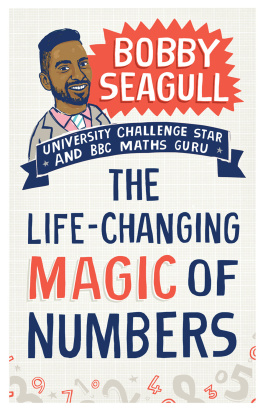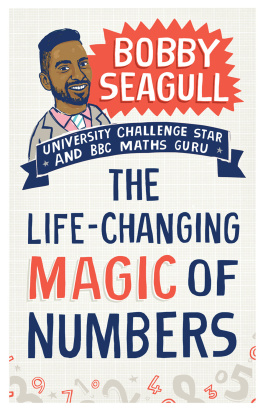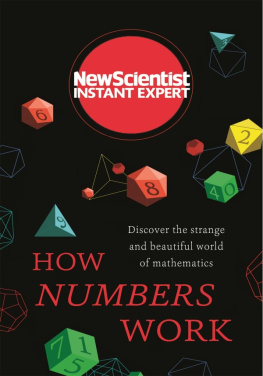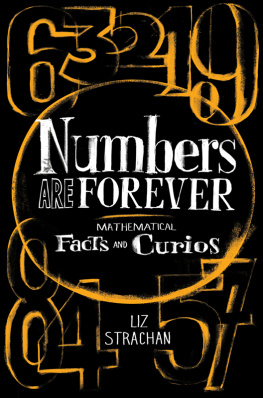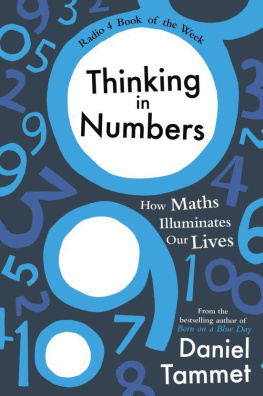Contents
About the Book
Hack your life with maths!
Once you know how to see them, numbers are all around us buried in the dimensions of buildings and encoding the data on our favourite gadgets. Theyre a beautiful system of patterns and codes, but also an essential tool that can guide our daily decisions, change our behaviour, and even predict the futureif we can just learn how to use them right.
Long before his rise to cult fandom on University Challenge, Bobby Seagull was obsessed with numbers. They were the keys that unlocked of the randomness of football results, helped him organise his time, directed his social life and opened up the world of music. Told through stories from his life, Bobby illuminates the world of numbers and brings his infectious enthusiasm to everything from the mystery of magic numbers, the improbability of probability, the right number of friends to have, and how prime numbers control everything from credit card encryption to cicada hibernation habits.
The Life-Changing Magic of Numbers will fill you with wonder, change how you see the world around you, and help you use numbers to make better choices and decisions every day.
About the Author
Bobby Seagull became a cult star as a contestant on University Challenge in 2017. He is now an obsessive quiz enthusiast, secondary school maths teacher, a doctorate student researching maths anxiety at Cambridge University and a long-suffering West Ham fan.
To my family without whom I would not be the person I am today.
CHAPTER 1
Its Easy as 1, 2, 3
Counting, Ordering Numbers and Basic Data Handling Tools
It was the winter of 1993, Meat Loafs Id Do Anything For Love was number 1 in the charts, and I was a small boy of 9 standing in the playground in an oversized hooded winter jacket, clutching my most prized possession: the Merlin 199394 Premier League football collection sticker book. Growing up as a child in 1990s east London, the language of the playground was football and the currency to participate was football stickers.
Got, got, got, need. This was a phrase that frequently passed my lips, as I attempted to barter stickers with other children. I calmly stated the stickers that I had already got in my collection, but excitedly blurted out need for the stickers that were still required. After the school bell rang out for the weekend, my regular Friday afternoon rush was to the local corner shop. I would spend my few pounds of pocket money on several packets of overpriced adhesive labels.
My friends not only traded stickers, but we used to hypothesise about which players would make the ideal transfer. While Blackburn Rovers prolific striker Alan Shearer would be more suited to Alex Fergusons forward line at Manchester United, children could dream of a world where Alan would ply his trade at West Hams Upton Park. The sticker world was clearly not the real world!
This is where numbers first played a role in my social identity. Of course, my first connection with numbers was that most simple pleasure, one of counting basic numbers: 1, 2, 3 However, it was in this new setting that I found numbers coming into their own. Most footballing conversations with my peers were based on assertions without evidence such as saying that Arsenals Ian Wright was a more effective striker than Southamptons Matt Le Tissier but the confidence to use numbers helped me to carve my own identity. I knew that these strikers had both scored 15 goals in their previous league campaigns and this fact helped to add credence to my arguments.
After swapping new stickers, I recall rushing home with my sticker book and furiously tapping in the information on all my new stickers into my master spreadsheet in Microsoft Excel. For example, with Manchester Uniteds striker Eric Cantona, I entered his personal details (height 1.86 metres, weight 81 kilograms) and his performance statistics (33 appearances; 2 substitute; 15 goals, of which 10 were with the right foot, 1 with the left foot and 4 with the head). A few years later in secondary school, I progressed onto using the database software Microsoft Access for this same task but with more efficiency. Inputs included players names, starting position, heights and data from the previous year, such as games played and goals scored.
Armed with this, I was able make more accurate assessments about players. If a West Ham fan wanted to find out possible players who were defenders, more than 1.83 metres and played more than 20 games in the season prior, a quick sorting formula on Excel would weave its magic. And bam! I would be able to come up with a list of a few players who could fit the bill.
I found the relatively painless skill to rank players by different criteria in my spreadsheet height, goals scored or games played allowed me to turn a complex world into something I could begin to fathom. This balanced my subjective opinions of players based on their trickery and confidence on the ball with objective comparisons of players. Apparently meaningless numbers, such as the heights of various players, could be brought to life with basic data techniques such as mean, median and modes that let me compare them against each other. Suddenly I could impress my friends with answers to questions like Which is the average tallest squad in the league? or Which team has the highest number of goals being contributed from midfield? All straightforward to interrogate within a few clicks of Excel. Perhaps I missed a trick in not turning this objective analysis of football into a business now companies like Opta Sports have done so with shrewd commercial success!
What numbers gave me was a sense of knowing in a world of conjecture. Like Linuss security blanket in the Snoopy cartoons, numbers gave me a bedrock upon which to form myself. In fact, if Im really honest my sense of the certainty of data can be traced back a couple of years earlier than the Premier League sticker book. It stemmed from a Christmas gift in 1991 and a book that perhaps changed my life and rooted my love of numbers, data and information: The Top 10 of Everything 1992 by Russell Ash. From the moment I delicately unwrapped the paper from this gift, I was devouring ordered lists. Lists about the Top 10 tallest buildings in the world, the Top 10 grossing films at the box office, the Top 10 longest migration paths of any species, and more. You name a topic astronomy, art, food and drink, music and I could start reciting off lists at breakneck speed (perhaps without quite understanding what lay behind the numbers).
The 1992 Barcelona Olympic summer games was the first time I saw a visually captivating way numbers could express the physical peak of young athletes: Team GB captain Linford Christie storming through to win the 100 metres in 9.96 seconds; Carl Lewis edging out Mike Powell by 3 centimetres in an epic mens long jump final; Lavinia Milosovicis mesmerising floor routine in the gymnastics to secure her a perfect 10.0 score. As a little boy, I was sprawled on the living room floor, scoffing my face with digestive biscuits and fixated by the sports. I was slowly coming to understand that numbers were a way of working out sizes and sequences, and establishing who the winners and losers were. Numbers were abundant in my eyes, ranking and ordering competitors and nations, trying to objectively quantify things that seemed a million miles from my maths lessons at school.

